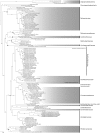Genome evolution and phylogenomic analysis of Candidatus Kinetoplastibacterium, the betaproteobacterial endosymbionts of Strigomonas and Angomonas
- PMID: 23345457
- PMCID: PMC3590767
- DOI: 10.1093/gbe/evt012
Genome evolution and phylogenomic analysis of Candidatus Kinetoplastibacterium, the betaproteobacterial endosymbionts of Strigomonas and Angomonas
Abstract
It has been long known that insect-infecting trypanosomatid flagellates from the genera Angomonas and Strigomonas harbor bacterial endosymbionts (Candidatus Kinetoplastibacterium or TPE [trypanosomatid proteobacterial endosymbiont]) that supplement the host metabolism. Based on previous analyses of other bacterial endosymbiont genomes from other lineages, a stereotypical path of genome evolution in such bacteria over the duration of their association with the eukaryotic host has been characterized. In this work, we sequence and analyze the genomes of five TPEs, perform their metabolic reconstruction, do an extensive phylogenomic analyses with all available Betaproteobacteria, and compare the TPEs with their nearest betaproteobacterial relatives. We also identify a number of housekeeping and central metabolism genes that seem to have undergone positive selection. Our genome structure analyses show total synteny among the five TPEs despite millions of years of divergence, and that this lineage follows the common path of genome evolution observed in other endosymbionts of diverse ancestries. As previously suggested by cell biology and biochemistry experiments, Ca. Kinetoplastibacterium spp. preferentially maintain those genes necessary for the biosynthesis of compounds needed by their hosts. We have also shown that metabolic and informational genes related to the cooperation with the host are overrepresented amongst genes shown to be under positive selection. Finally, our phylogenomic analysis shows that, while being in the Alcaligenaceae family of Betaproteobacteria, the closest relatives of these endosymbionts are not in the genus Bordetella as previously reported, but more likely in the Taylorella genus.
Figures



References
-
- Alves JMP, Buck GA. Automated system for gene annotation and metabolic pathway reconstruction using general sequence databases. Chem Biodivers. 2007;4:2593–2602. - PubMed
-
- Anisimova M, Bielawski JP, Yang Z. Accuracy and power of the likelihood ratio test in detecting adaptive molecular evolution. Mol Biol Evol. 2001;18:1585–1592. - PubMed
Publication types
MeSH terms
Substances
Associated data
- Actions
- Actions
- Actions
- Actions
- Actions
LinkOut - more resources
Full Text Sources
Other Literature Sources
Molecular Biology Databases
Research Materials
Miscellaneous

